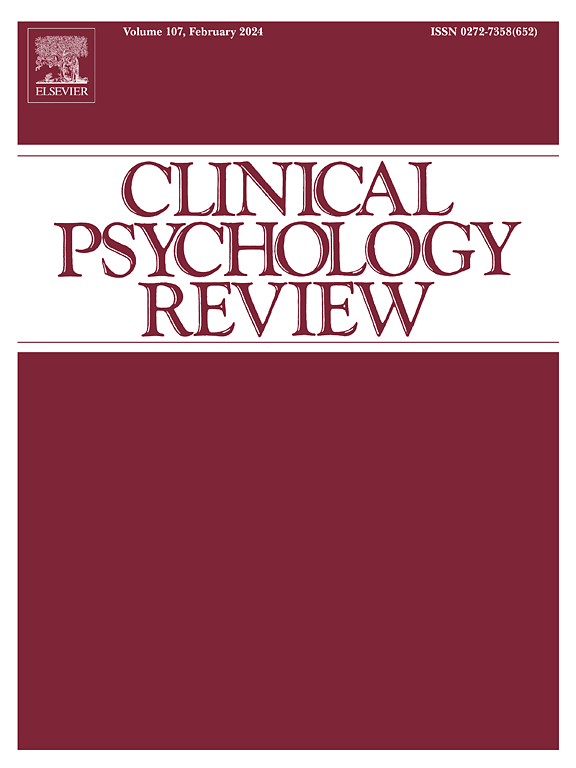Multidimensional perspective of dissociation and suicide-related outcomes: A Meta-analysis and systematic review
IF 12.2
1区 心理学
Q1 PSYCHOLOGY, CLINICAL
引用次数: 0
Abstract
Background
The relationship between suicide-related outcomes and dissociation is a critical issue. In recent years, research has focused on understanding dissociation as an acquired capacity factor for suicide attempts. Moreover, meta-analysis findings demonstrate the relationship between dissociation and suicidal ideation. To unravel the role of dissociation in the development of suicidal ideation and attempt, this study adopts a multidimensional perspective, that conceptualizes a complex construct comprising distinct but related domains which reflects disruptions in perception, cognition, emotion, and somatic experience.
Methods
We conducted systematic research on the main databases (PubMed, Medline, APA PsycInfo, Scopus, Web of Science, APA PsycArticles), collecting the literature of the last 30 years. A total of 84 studies (Ntotalsample = 129.582) studies were included in the systematic review. Of these, 68 studies were included in the meta-analysis. The analyses are based on the Pearson correlation coefficient as the effect size for the relationship between suicide-related outcomes and dissociation domains. The outcome variables included suicidal ideation, suicide attempts, and suicide risk - a composite or dimensional construct reflecting the likelihood of suicidal thoughts or behaviors, as well as specific psychological factors associated with the emergence of suicidal outcomes, as reported in the selected studies.
We used a random effects model, conducted moderation analyses to explain the heterogeneity of study variance, controlled for publication bias, and assessed the methodological quality of the included studies.
Results
General dissociation was significantly correlated with suicidal risk (r = 0.29; p < .001), suicidal ideation (r = 0.25; p < .001), and suicide attempts (r = 0.27; p < .001). A positive and significant relationship was found between suicidal ideation and detachment (r = 0.31; p < .001), as well as with maladaptive daydreaming (r = 0.27; p < .001). A statistically significant but small association was also observed between suicide attempts and somatoform dissociation (r = 0.02; p < .001), whereas a stronger connection was found with suicidal ideation (r = 0.31; p < .001). Moderator effects related to sample characteristics, sociocultural factors, and methodological quality of studies were identified with no evidence of publication bias.
Conclusions
These findings support the importance of a multidimensional approach to examining dissociation and suicide-related outcomes, revealing differential relationships based on the specific domains assessed. The resulting clinical implications and future directions are discussed.
分离和自杀相关结果的多维视角:荟萃分析和系统回顾
自杀相关结果和分离之间的关系是一个关键问题。近年来,研究集中在理解解离是自杀企图的获得性能力因素。此外,荟萃分析结果证实了分离与自杀意念之间的关系。为了揭示分离在自杀意念和企图发展中的作用,本研究采用了多维视角,将一个复杂的结构概念化,该结构由不同但相关的领域组成,反映了感知、认知、情感和躯体体验的中断。
本文章由计算机程序翻译,如有差异,请以英文原文为准。
求助全文
约1分钟内获得全文
求助全文
来源期刊

Clinical Psychology Review
PSYCHOLOGY, CLINICAL-
CiteScore
23.10
自引率
1.60%
发文量
65
期刊介绍:
Clinical Psychology Review serves as a platform for substantial reviews addressing pertinent topics in clinical psychology. Encompassing a spectrum of issues, from psychopathology to behavior therapy, cognition to cognitive therapies, behavioral medicine to community mental health, assessment, and child development, the journal seeks cutting-edge papers that significantly contribute to advancing the science and/or practice of clinical psychology.
While maintaining a primary focus on topics directly related to clinical psychology, the journal occasionally features reviews on psychophysiology, learning therapy, experimental psychopathology, and social psychology, provided they demonstrate a clear connection to research or practice in clinical psychology. Integrative literature reviews and summaries of innovative ongoing clinical research programs find a place within its pages. However, reports on individual research studies and theoretical treatises or clinical guides lacking an empirical base are deemed inappropriate for publication.
 求助内容:
求助内容: 应助结果提醒方式:
应助结果提醒方式:


